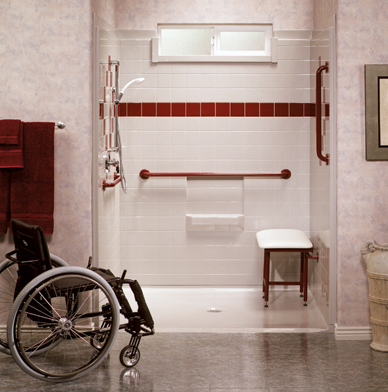Assessing Disability Levels For Handicap Bath Remodeling
Before you can decide on a plan for remodeling a bathroom to improve access, it is imperative to first take an inventory of the users level of disability. The level of disability and the prognosis for improvement or deterioration of the condition will have a major impact on your remodeling plans.
Ambulatory Persons: If a person is ambulatory it means they are capable of getting up and walking with or without an asistive device like a rollator, walker or cane and with or without a Caregiver assisting them to a standing position. While there are many disability levels associated with ambulatory persons, it is fairly safe to assume that level one bathroom remodeling will generally make the bathroom functional.
Level One Handicap Bathroom Remodeling: These types of solutions would include grab bars, toilet safety rails, low threshold handicap showers, sliding transfer benches, standard transfer benches, etc. We will delve into each type of solution more deeply in later articles. Suffice to say that these types of solutions are relatively inexpensive in most cases and require just some simple planning which likewise, we will cover in detail later.
Non-ambulatory Persons: Exactly opposite of ambulatory, non-ambulatory users will include any persons that cannot stand and walk with or without assistance. In this instance the level of remodeling needs will greatly expand. A non ambulatory person might be able to sit up on their own or bath themselves once assisted into a tub or shower. Level two remodeling would be required in this situation.
Level Two Handicap Bathroom Remodeling: Level two handicap bathroom remodeling can include wheelchair accessible doorways, roll in wheelchair accessible showers, accessible toilets and vanities, etc. Again, we will dig deeper into these solutions as we go forward.
Level Three Handicap Bathroom Remodeling: This level becomes necessary for the care and bathing of non-ambulatory patients with advanced physical limitations. These would be individuals that require complete assistance from a Caregiver. In this case, careful planning would be needed to assess bathing needs, toileting choices, etc. A wide range of rehabilitation products are available to suit most needs.
The goal here is to assess disability levels as they relate to handicap bathroom remodeling. This article is not intended to be any sort of instruction for assessing disability in relation to medical treatment, disability claims, etc. In those situations a professional should always be consulted.

Recent Posts
-
How Managers Can Make Sure Buildings Are Accessible
Source: controlyourbuilding.com | Re-Post Careprodx 9/1/2016 - A moment seared into histor …3rd May 2024 -
Preferred Shower Chair Seat Height
One of the comments we hear on a regular basis is, "I don't know what seat height I need". And …1st May 2024 -
Think Twice Before Installing That Walk In Tub or Walk In Shower
We talk to a lot of people at CareProdx.com. A constant problem that arises for persons with d …1st May 2024


